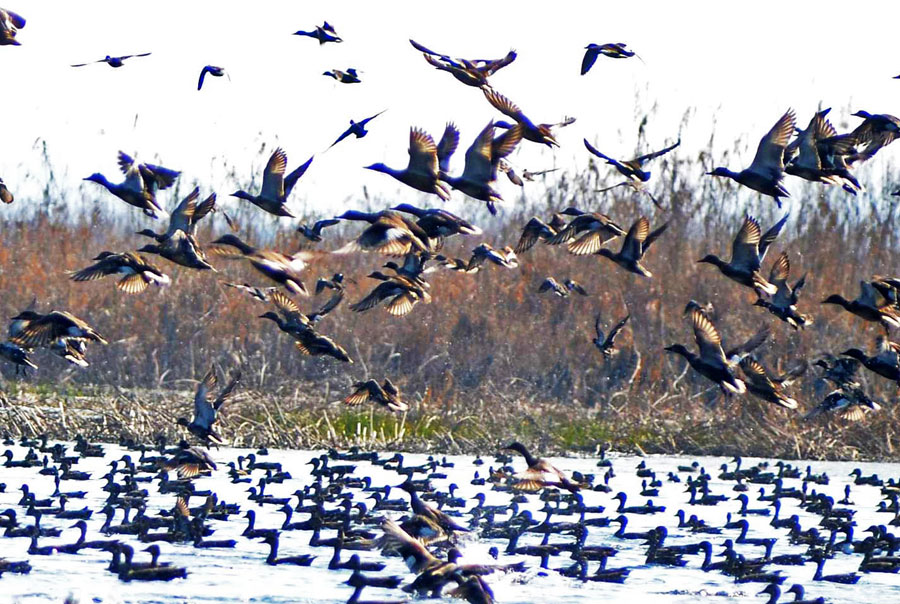
4 Lakh Migratory Birds Arrive In Four Wetlands Of Valley
Srinagar: Navigating with the help of stars, moon and peaks and maintaining a centuries-old tryst with Kashmir valley, the migratory birds have started to arrive here from far-off lands in an attempt to escape the harsh winter months of other countries for the relatively less harsh cold of Kashmir.
These hardy souls fly from Siberia, North-China, Philippines and North Europe to ward-off the extreme cold of their summer homes for their transitory habitat, Kashmir.
Rashid Naqash, Regional Wildlife Warden(Wetlands) told Kashmir Observer that these migratory birds have already started arriving in Kashmir’s wetland and their numbers have reached to more than 4 lakh.
“By the middle of this month, we are expecting large numbers of these avian visitors, who come here to spend the winter months to escape the extreme cold of their summer homes,” Naqash said.
Having an upper hand over other states of India, J&K has four wetlands identified as Ramsar Sites and the migratory destination for birds arriving from Siberia and other places. Wular Lake, Dal Lake, Hokersar and Mirgund Lake are among a few important wetlands of the valley where these migratory birds have been making a temporary shelter for the winter months.
“These are the transitory homes to different kinds of migratory birds like Greylag Goose, Brahminy Duck, Tufted Duck, Gadwall, Northern Pintail, Common Pochard, Red-Crested Pochard, Ruddy Shelduck and Garganey are some of the migratory birds sighted in the wetlands of Kashmir during these winter months,” the Regional Wildlife Warden said.
“The migratory bird species that have arrived in the valley so far include geese, mallards, pochards, gadwalls, pintails, waders, coots and the common teals. Every year more than 33 species of Ducks and other migratory birds arrive in Kashmir,” he said.
He further added that, “At present, we have around a lakh migratory birds in Hokersar bird reserve, another lakh in Hygam and 50,000 in Shallabugh bird reserve. “In addition, there are 20,000 birds in Chatlum, 30,000 in the Wular Lake, and over a lakh in the Dal Lake in Srinagar.”
Notably, as the yearly arrival of these winged visitors starts in the valley, the threat of them being poached and hunted by the ongoing human intervention has also augmented.
“Inside the bird reserves like Hokersar, Hygam and Shallabugh, where permanent staff of the department is posted, we have no threat of poachers,” Naqash said.
“But, the real threat of these birds falling prey to poaching becomes a problem in unprotected and isolated wetlands where there’s no availability of Department provided permanent staff,” he added.
It is pertinent to mention here that killing of these migratory birds has been an offence under the local laws of J&K, enacted in 1978 that were later repealed and replaced by the Indian wildlife Protection Act of 1972, when the special status of J&K was abrogated and the erstwhile state was downgraded into two Union Territories.
“Last year, around 10 lakh migratory birds had arrived in Kashmir and we’re sure by February next year, the number will be much higher than their last arrival in the valley.” Naqash told Kashmir Observer.
Follow this link to join our WhatsApp group: Join Now
Be Part of Quality Journalism |
Quality journalism takes a lot of time, money and hard work to produce and despite all the hardships we still do it. Our reporters and editors are working overtime in Kashmir and beyond to cover what you care about, break big stories, and expose injustices that can change lives. Today more people are reading Kashmir Observer than ever, but only a handful are paying while advertising revenues are falling fast. |
| ACT NOW |
| MONTHLY | Rs 100 | |
| YEARLY | Rs 1000 | |
| LIFETIME | Rs 10000 | |









